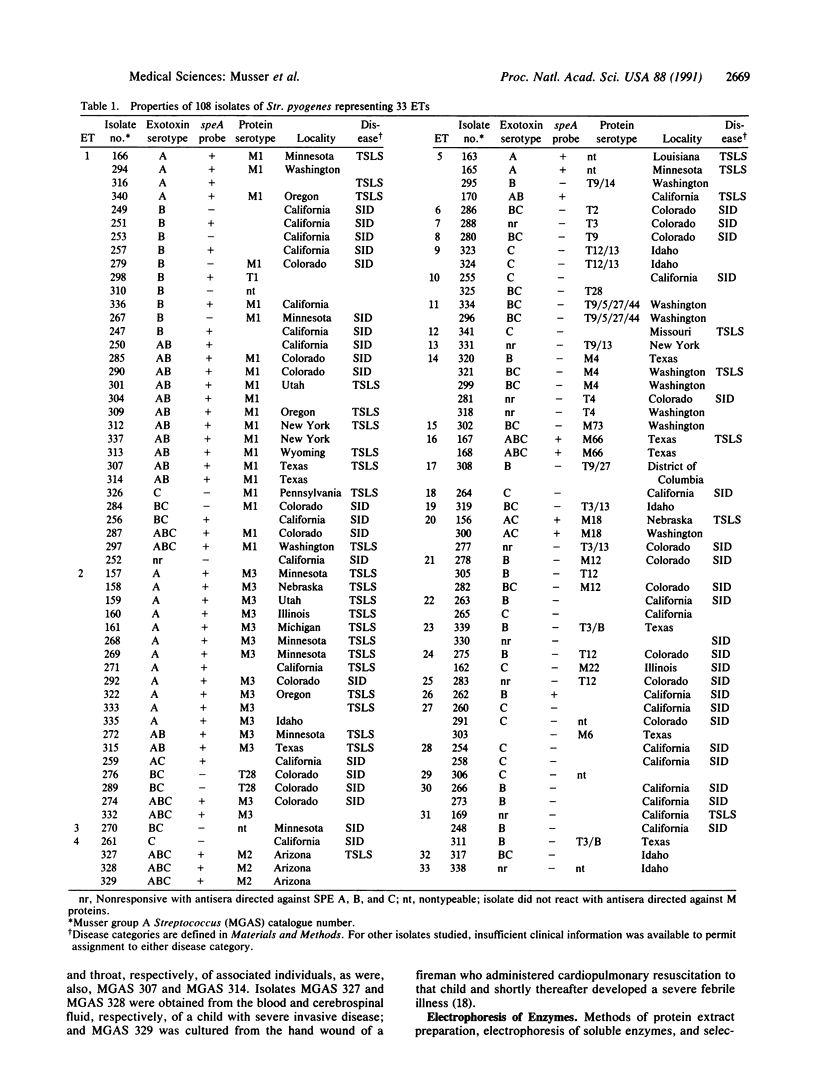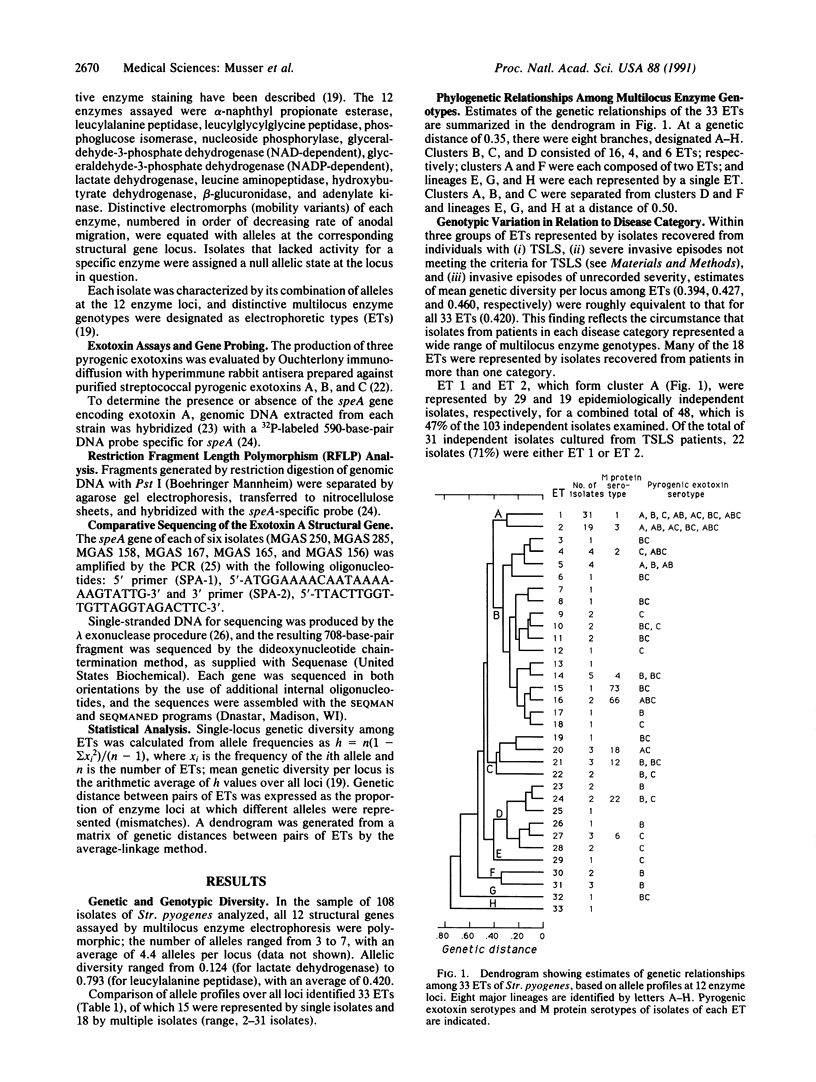Abstract
Genetic diversity and relationships among 108 isolates of the bacterium Streptococcus pyogenes recently recovered from patients in the United States with toxic-shock-like syndrome or other invasive diseases were estimated by multilocus enzyme electrophoresis. Thirty-three electrophoretic types (ETs), representing distinctive multilocus clonal genotypes, were identified, but nearly half the disease episodes, including more than two-thirds of the cases of toxic-shock-like syndrome, were caused by strains of two related clones (ET 1 and ET 2). These two clones were also represented by recent pathogenic European isolates. A previous report of a relatively high frequency of expression of exotoxin A among isolates recovered from toxic-shock-like syndrome patients in the United States was confirmed; and the demonstration of this association both within clones and among distantly related clones supports the hypothesis that exotoxin A is a causal factor in pathogenesis of this disease. Near identity of the nucleotide sequences of the exotoxin A structural gene of six isolates of five ETs in diverse phylogenetic lineages was interpreted as evidence that the gene has been horizontally distributed among clones, presumably by bacteriophage-mediated transfer.
Full text
PDF




Selected References
These references are in PubMed. This may not be the complete list of references from this article.
- Bartter T., Dascal A., Carroll K., Curley F. J. 'Toxic strep syndrome'. A manifestation of group A streptococcal infection. Arch Intern Med. 1988 Jun;148(6):1421–1424. doi: 10.1001/archinte.148.6.1421. [DOI] [PubMed] [Google Scholar]
- Begovac J., Marton E., Lisić M., Beus I., Bozinović D., Kuzmanović N. Group A beta-hemolytic streptococcal toxic shock-like syndrome. Pediatr Infect Dis J. 1990 May;9(5):369–370. doi: 10.1097/00006454-199005000-00013. [DOI] [PubMed] [Google Scholar]
- Cone L. A., Woodard D. R., Schlievert P. M., Tomory G. S. Clinical and bacteriologic observations of a toxic shock-like syndrome due to Streptococcus pyogenes. N Engl J Med. 1987 Jul 16;317(3):146–149. doi: 10.1056/NEJM198707163170305. [DOI] [PubMed] [Google Scholar]
- Dobson S. R. Group A streptococci revisited. Arch Dis Child. 1989 Jul;64(7):977–980. doi: 10.1136/adc.64.7.977. [DOI] [PMC free article] [PubMed] [Google Scholar]
- Francis J., Warren R. E. Streptococcus pyogenes bacteraemia in Cambridge--a review of 67 episodes. Q J Med. 1988 Aug;68(256):603–613. [PubMed] [Google Scholar]
- Gaworzewska E., Colman G. Changes in the pattern of infection caused by Streptococcus pyogenes. Epidemiol Infect. 1988 Apr;100(2):257–269. doi: 10.1017/s095026880006739x. [DOI] [PMC free article] [PubMed] [Google Scholar]
- Goshorn S. C., Bohach G. A., Schlievert P. M. Cloning and characterization of the gene, speC, for pyrogenic exotoxin type C from Streptococcus pyogenes. Mol Gen Genet. 1988 Apr;212(1):66–70. doi: 10.1007/BF00322445. [DOI] [PubMed] [Google Scholar]
- Goshorn S. C., Schlievert P. M. Bacteriophage association of streptococcal pyrogenic exotoxin type C. J Bacteriol. 1989 Jun;171(6):3068–3073. doi: 10.1128/jb.171.6.3068-3073.1989. [DOI] [PMC free article] [PubMed] [Google Scholar]
- Group A streptococcal infections and a toxic shock-like syndrome. N Engl J Med. 1989 Nov 30;321(22):1545–1547. doi: 10.1056/NEJM198911303212212. [DOI] [PubMed] [Google Scholar]
- Group A streptococcal infections and a toxic shock-like syndrome. N Engl J Med. 1989 Nov 30;321(22):1545–1547. doi: 10.1056/NEJM198911303212212. [DOI] [PubMed] [Google Scholar]
- Hallas G. The production of pyrogenic exotoxins by group A streptococci. J Hyg (Lond) 1985 Aug;95(1):47–57. doi: 10.1017/s0022172400062276. [DOI] [PMC free article] [PubMed] [Google Scholar]
- Harnden A., Lennon D. Serious suppurative group A streptococcal infections in previously well children. Pediatr Infect Dis J. 1988 Oct;7(10):714–718. doi: 10.1097/00006454-198810000-00010. [DOI] [PubMed] [Google Scholar]
- Higuchi R. G., Ochman H. Production of single-stranded DNA templates by exonuclease digestion following the polymerase chain reaction. Nucleic Acids Res. 1989 Jul 25;17(14):5865–5865. doi: 10.1093/nar/17.14.5865. [DOI] [PMC free article] [PubMed] [Google Scholar]
- Hríbalová V. Streptococcus pyogenes and the toxic shock syndrome. Ann Intern Med. 1988 May;108(5):772–772. doi: 10.7326/0003-4819-108-5-772_2. [DOI] [PubMed] [Google Scholar]
- Ispahani P., Donald F. E., Aveline A. J. Streptococcus pyogenes bacteraemia: an old enemy subdued, but not defeated. J Infect. 1988 Jan;16(1):37–46. doi: 10.1016/s0163-4453(88)96073-2. [DOI] [PubMed] [Google Scholar]
- Johnson L. P., Schlievert P. M. Group A streptococcal phage T12 carries the structural gene for pyrogenic exotoxin type A. Mol Gen Genet. 1984;194(1-2):52–56. doi: 10.1007/BF00383496. [DOI] [PubMed] [Google Scholar]
- Johnson L. P., Tomai M. A., Schlievert P. M. Bacteriophage involvement in group A streptococcal pyrogenic exotoxin A production. J Bacteriol. 1986 May;166(2):623–627. doi: 10.1128/jb.166.2.623-627.1986. [DOI] [PMC free article] [PubMed] [Google Scholar]
- Köhler W. Streptococcal toxic shock syndrome. Zentralbl Bakteriol. 1990 Mar;272(3):257–264. doi: 10.1016/s0934-8840(11)80026-5. [DOI] [PubMed] [Google Scholar]
- Lee P. K., Schlievert P. M. Quantification and toxicity of group A streptococcal pyrogenic exotoxins in an animal model of toxic shock syndrome-like illness. J Clin Microbiol. 1989 Aug;27(8):1890–1892. doi: 10.1128/jcm.27.8.1890-1892.1989. [DOI] [PMC free article] [PubMed] [Google Scholar]
- Musser J. M., Schlievert P. M., Chow A. W., Ewan P., Kreiswirth B. N., Rosdahl V. T., Naidu A. S., Witte W., Selander R. K. A single clone of Staphylococcus aureus causes the majority of cases of toxic shock syndrome. Proc Natl Acad Sci U S A. 1990 Jan;87(1):225–229. doi: 10.1073/pnas.87.1.225. [DOI] [PMC free article] [PubMed] [Google Scholar]
- Reingold A. L., Hargrett N. T., Shands K. N., Dan B. B., Schmid G. P., Strickland B. Y., Broome C. V. Toxic shock syndrome surveillance in the United States, 1980 to 1981. Ann Intern Med. 1982 Jun;96(6 Pt 2):875–880. doi: 10.7326/0003-4819-96-6-875. [DOI] [PubMed] [Google Scholar]
- Saiki R. K., Gelfand D. H., Stoffel S., Scharf S. J., Higuchi R., Horn G. T., Mullis K. B., Erlich H. A. Primer-directed enzymatic amplification of DNA with a thermostable DNA polymerase. Science. 1988 Jan 29;239(4839):487–491. doi: 10.1126/science.2448875. [DOI] [PubMed] [Google Scholar]
- Selander R. K., Caugant D. A., Ochman H., Musser J. M., Gilmour M. N., Whittam T. S. Methods of multilocus enzyme electrophoresis for bacterial population genetics and systematics. Appl Environ Microbiol. 1986 May;51(5):873–884. doi: 10.1128/aem.51.5.873-884.1986. [DOI] [PMC free article] [PubMed] [Google Scholar]
- Selander R. K., Levin B. R. Genetic diversity and structure in Escherichia coli populations. Science. 1980 Oct 31;210(4469):545–547. doi: 10.1126/science.6999623. [DOI] [PubMed] [Google Scholar]
- Southern E. M. Detection of specific sequences among DNA fragments separated by gel electrophoresis. J Mol Biol. 1975 Nov 5;98(3):503–517. doi: 10.1016/s0022-2836(75)80083-0. [DOI] [PubMed] [Google Scholar]
- Stevens D. L., Tanner M. H., Winship J., Swarts R., Ries K. M., Schlievert P. M., Kaplan E. Severe group A streptococcal infections associated with a toxic shock-like syndrome and scarlet fever toxin A. N Engl J Med. 1989 Jul 6;321(1):1–7. doi: 10.1056/NEJM198907063210101. [DOI] [PubMed] [Google Scholar]
- Valenzuela T. D., Hooton T. M., Kaplan E. L., Schlievert P. Transmission of 'toxic strep' syndrome from an infected child to a firefighter during CPR. Ann Emerg Med. 1991 Jan;20(1):90–92. doi: 10.1016/s0196-0644(05)81129-1. [DOI] [PubMed] [Google Scholar]
- Weeks C. R., Ferretti J. J. Nucleotide sequence of the type A streptococcal exotoxin (erythrogenic toxin) gene from Streptococcus pyogenes bacteriophage T12. Infect Immun. 1986 Apr;52(1):144–150. doi: 10.1128/iai.52.1.144-150.1986. [DOI] [PMC free article] [PubMed] [Google Scholar]
- Whittam T. S., Wachsmuth I. K., Wilson R. A. Genetic evidence of clonal descent of Escherichia coli O157:H7 associated with hemorrhagic colitis and hemolytic uremic syndrome. J Infect Dis. 1988 Jun;157(6):1124–1133. doi: 10.1093/infdis/157.6.1124. [DOI] [PubMed] [Google Scholar]
- Wong V. K., Wright H. T., Jr Group A beta-hemolytic streptococci as a cause of bacteremia in children. Am J Dis Child. 1988 Aug;142(8):831–833. doi: 10.1001/archpedi.1988.02150080037016. [DOI] [PubMed] [Google Scholar]
- Yagupsky P., Giladi Y. Group A beta-hemolytic streptococcal bacteremia in children. Pediatr Infect Dis J. 1987 Nov;6(11):1036–1039. [PubMed] [Google Scholar]
- Yu C. E., Ferretti J. J. Molecular epidemiologic analysis of the type A streptococcal exotoxin (erythrogenic toxin) gene (speA) in clinical Streptococcus pyogenes strains. Infect Immun. 1989 Dec;57(12):3715–3719. doi: 10.1128/iai.57.12.3715-3719.1989. [DOI] [PMC free article] [PubMed] [Google Scholar]


